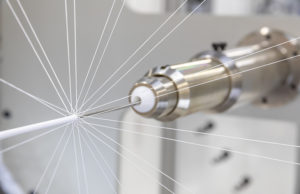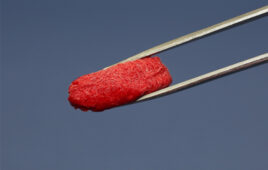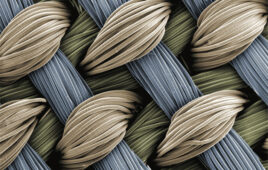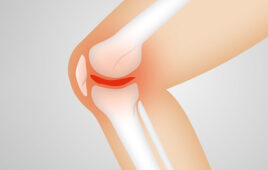Orthopedic OEMs are looking to medical textiles for minimally invasive approaches to applications ranging from soft-tissue tears to bone grafts to spinal stabilization and more.
Jeffrey M. Koslosky, Cortland Biomedical

High-density braider (Image from Cortland Biomedical)
In the orthopedic sector, demographics are noticeably shifting toward younger and more physically active surgical patients. Soft-tissue injuries, including damage to the ligaments and tendons commonly associated with sports injuries amongst a younger generation of patients, are becoming increasingly common.
This phenomenon dovetails with the trend away from large-scale surgeries and toward earlier intervention with less-invasive devices to reduce hospital stays and recovery times. Preservation of the patient’s range of motion and natural movement is a primary objective, particularly when it comes to spinal injuries.
Medical device OEMs in this highly competitive orthopedic space are adapting by looking to medical textiles to offer minimally invasive approaches for applications including soft-tissue tears, bone grafts and spinal stabilization, to name a few.
How textiles work in orthopedics
Traditionally, braided textiles have been widely deployed as orthopedic sutures, often fabricated using ultra-high-molecular-weight polyethylene (UHMWPE) or other high-strength polymeric fibers. Often the goal of these structures is to enable an effective repair by allowing a surgeon to secure soft and bony tissue using a braid with a low profile and high tensile strength.
Advances in braided textiles allow for additional design features, such as the inclusion of regions of variable density or the ability to branch off, creating a multiaxial structure with a common hub. These advances allow for improved handling characteristics, better knot retention and less mass of implanted material, which can simplify the procedure and facilitate a more durable surgical repair.
Another benefit of biomedical textiles is their shape-transformation properties. Because they are inherently compressible and flexible, they can be used in minimally invasive delivery applications — entering through a small hole and expanding in the body as needed. Fabric porosity can also be tailored by the type of textile-forming technology and by varying orientations in its geometry, ultimately eliciting tissue in-growth in certain areas while serving as a tissue barrier in others.
Fabric-based biomaterial structures can be engineered with specific porosity characteristics to control the flow of materials and to facilitate biologic healing in a localized treatment site. This offers an option to use a fabric as a containment vessel for orthopedic materials, such as bone cement, with advantages unrivaled by more common device materials.
Recent updates
More recently, woven and knitted biomedical textile structures have emerged as an optimal foundation for orthopedic implants and anchor points for attaching soft tissue. This is largely due to their strength, compliance and inherent capabilities for promoting tissue ingrowth. These textile structures can distribute load over a larger surface area and may be engineered to mimic the behavior of the ruptured tendons and ligaments they are intended to replace.
The mechanical and biologic properties of textile structures can be tailored for specific uses, such as regenerative scaffolding or as partially resorbable structures that enable healing. This is especially useful in the surgical repairs of tissue that is minimally vascularized, as is commonly seen in joint repair.
For tissue-engineering applications, composite scaffolds can be created using hybrids of biologic and synthetic materials. Textile structures created from resorbable synthetics allow controlled resorption of the polymers aligned with the healing rate of the tissue, resulting in a more complete repair.
The potential combination of synthetic biomaterials with osteoinductive materials can produce a multi-component scaffold structure with the ability to form new tissue using the body’s cellular response to biochemical signals, according to Steven M. Kurtz and Avram Allan Edidin in the Spine Technology Handbook. These biomedical textile composites have a high level of orientation and localized containment not possible with other common scaffold materials such as sponges, foams and porous metals, making them better suited for spinal fusion, long-bone fracture and bone-void applications.
High-performance biomedical textiles represent an exciting opportunity to increase innovation in the orthopedic market and provide less-invasive surgical options for patients. The design flexibility and shape transformation properties of medical textiles, as well as their compatibility with biologic structures and ability to be tailored to the needs of the particular application, mean that patients may benefit from simpler procedures, faster healing times and less risk of complications or rejection.
Jeffrey Koslosky is director of Engineering & Product Development for Cortland Biomedical.
He is experienced in biomedical product design and engineering and drives new business through the intersection of medical device technology and textile structure formation.
The opinions expressed in this blog post are the author’s only and do not necessarily reflect those of Medical Design and Outsourcing or its employees.




